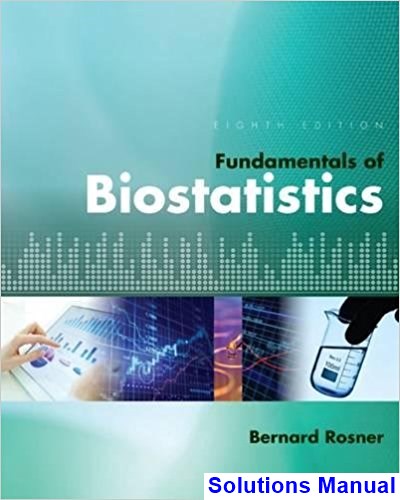Fundamentals of Biostatistics 8th Edition Rosner Solutions Manual

Product details:
- ISBN-10 : 130526892X
- ISBN-13 : 978-1305268920
- Author: Bernard Rosner
FUNDAMENTALS OF BIOSTATISTICS leads you through the methods, techniques, and computations of statistics necessary for success in the medical field. Every new concept is developed systematically through completely worked out examples from current medical research problems.
Table contents:
- Chapter 1: General Overview
- Chapter 2: Descriptive Statistics
- 2.1 Introduction
- 2.2 Measures of Location
- 2.3 Some Properties of the Arithmetic Mean
- 2.4 Measures of Spread
- 2.5 Some Properties of the Variance and Standard Deviation
- 2.6 The Coefficient of Variation
- 2.7 Grouped Data
- 2.8 Graphic Methods
- 2.9 Case Study 1: Effects of Lead Exposureon Neurological and Psychological Function in Children
- 2.10 Case Study 2: Effects of Tobacco Use on Bone-Mineral Density in Middle-Aged Women
- 2.11 Obtaining Descriptive Statistics on the Computer
- 2.12 Summary
- Problems
- Chapter 3: Probability
- 3.1 Introduction
- 3.2 Definition of Probability
- 3.3 Some Useful Probabilistic Notation
- 3.4 The Multiplication Law of Probability
- 3.5 The Addition Law of Probability
- 3.6 Conditional Probability
- 3.7 Bayes’ Rule and Screening Tests
- 3.8 Bayesian Inference
- 3.9 ROC Curves
- 3.10 Prevalence and Incidence
- 3.11 Summary
- Problems
- Chapter 4: Discrete Probability Distributions
- 4.1 Introduction
- 4.2 Random Variables
- 4.3 The Probability-Mass Function for a Discrete Random Variable
- 4.4 The Expected Value of a Discrete Random Variable
- 4.5 The Variance of a Discrete Random Variable
- 4.6 The Cumulative-Distribution Function of a Discrete Random Variable
- 4.7 Permutations and Combinations
- 4.8 The Binomial Distribution
- 4.9 Expected Value and Variance of the Binomial Distribution
- 4.10 The Poisson Distribution
- 4.11 Computation of Poisson Probabilities
- 4.12 Expected Value and Variance of the Poisson Distribution
- 4.13 Poisson Approximation to the Binomial Distribution
- 4.14 Summary
- Problems
- Chapter 5: Continuous Probability Distributions
- 5.1 Introduction
- 5.2 General Concepts
- 5.3 The Normal Distribution
- 5.4 Properties of the Standard Normal Distribution
- 5.5 Conversion from an N (μ,σ 2) Distribution to an N(0,1) Distribution
- 5.6 Linear Combinations of Random Variables
- 5.7 Normal Approximation to the Binomial Distribution
- 5.8 Normal Approximation to the Poisson Distribution
- 5.9 Summary
- Problems
- Chapter 6: Estimation
- 6.1 Introduction
- 6.2 The Relationship Between Population and Sample
- 6.3 Random-Number Tables
- 6.4 Randomized Clinical Trials
- 6.5 Estimation of the Mean of a Distribution
- 6.6 Case Study: Effects of Tobacco Use on Bone-Mineral Density (BMD) in Middle-Aged Women
- 6.7 Estimation of the Variance of a Distribution
- 6.8 Estimation for the Binomial Distribution
- 6.9 Estimation for the Poisson Distribution
- 6.10 One-Sided Confidence Intervals
- 6.11 The Bootstrap
- 6.12 Summary
- Problems
- Chapter 7: Hypothesis Testing: One-Sample Inference
- 7.1 Introduction
- 7.2 General Concepts
- 7.3 One-Sample Test for the Mean of a Normal Distribution: One-Sided Alternatives
- 7.4 One-Sample Test for the Mean of a Normal Distribution: Two-Sided Alternatives
- 7.5 The Relationship Between Hypothes is Testing and Confidence Intervals
- 7.6 The Power of a Test
- 7.7 Sample-Size Determination
- 7.8 One Sample X Square Test for the Variance of a Normal Distribution
- 7.9 One-Sample Inference forr the Binomial Distribution
- 7.10 One-Sample Inference for the Poisson Distribution
- 7.11 Case Study: Effects of Tobacco Use on Bone-Mineral Density in Middle-Aged Women
- 7.12 Derivation of Selected Formulas
- 7.13 Summary
- Problems
- Chapter 8: Hypothesis Testing: Two-Sample Inference
- 8.1 Introduction
- 8.2 The Paired t Test
- 8.3 Interval Estimation for the Comparison of Means from Two Paired Samples
- 8.4 Two-Sample t Test for Independent Samples with Equal Variances
- 8.5 Interval Estimation for the Comparison of Means from Two Independent Samples (Equal Variance Cas
- 8.6 Testing for the Equality of Two Variances
- 8.7 Two-Sample t Test for Independent Samples with Unequal Variances
- 8.8 Case Study: Effects of Lead Exposure on Neurologic and Psychological Function in Children
- 8.9 Estimation of Sample Size and Power for Comparing Two Means
- 8.10 The Treatment of Outliers
- 8.11 Derivation of Equation 8.13 (p. 290)
- 8.12 Summary
- Problems
- Chapter 9: Nonparametric Methods
- 9.1 Introduction
- 9.2 The Sign Test
- 9.3 The Wilcoxon Signed-Rank Test
- 9.4 The Wilcoxon Rank-Sum Test
- 9.5 Case Study: Effects of Lead Exposure on Neurological and Psychological Function in Children
- 9.6 Permutation Tests
- 9.7 Summary
- Problems
- Chapter 10: Hypothesis Testing: Categorical Data
- 10.1 Introduction
- 10.2 Two-Sample Test for Binomial Proportions
- 10.3 Fisher’s Exact Test
- 10.4 Two-Sample Test for Binomial Proportions for Matched-Pair Data (McNemar’s Test)
- 10.5 Estimation of Sample Size and Power for Comparing Two Binomial Proportions
- 10.6 R x C Contingency Tables
- 10.7 Chi-Square Goodness-of-Fit Test
- 10.8 The Kappa Statistic
- 10.9 Derivation of Selected Formulas
- 10.10 Summary
- Problems
- Chapter 11: Regression and Correlation Methods
- 11.1 Introduction
- 11.2 General Concepts
- 11.3 Fitting Regression Lines – The Method of Least Squares
- 11.4 Inferences About Parameters from Regression Lines
- 11.5 Interval Estimation for Linear Regression
- 11.6 Assessing the Goodness of Fit of Regression Lines
- 11.7 The Correlation Coefficient
- 11.8 Statistical Inference for Correlation Coefficients
- 11.9 Multiple Regression
- 11.10 Case Study: Effects of Lead Exposure on Neurologic and Psychological Function in Children
- 11.11 Partial and Multiple Correlation
- 11.12 Rank Correlation
- 11.13 Interval Estimation for Rank-Correlation Coefficients
- 11.14 Derivation of Equation 11.26 (page 499)
- 11.15 Summary
- Problems
- Chapter 12: Multisample Inference
- 12.1 Introduction to the One-Way Analysis of Variance
- 12.2 One-Way ANOVA – Fixed-Effects Model
- 12.3 Hypothesis Testing in One-Way ANOVA – Fixed-Effects Model
- 12.4 Comparisons of Specific Groups in One-Way ANOVA
- 12.5 Case Study: Effects of Lead Exposure on Neurologic and Psychological Function in Children
- 12.6 Two-Way ANOVA
- 12.7 The Kruskal-Wallis Test
- 12.8 One-Way ANOVA – The Random-Effects Model
- 12.9 The Intraclass Correlation Coefficient
- 12.10 Mixed Models
- 12.11 Derivation of Equation 12.30 (p.605)
- 12.12 Summary
- Problems
- Chapter 13: Design and Analysis Techniques for Epidemiologic Studies
- 13.1 Introduction
- 13.2 Study Design
- 13.3 Measures of Effect for Categorical Data
- 13.4 Attributable Risk
- 13.5 Confounding and Standardization
- 13.6 Methods of Inference for Stratified Categorical Data – The Mantel-Haenszel Test
- 13.7 Multiple Logistic Regression
- 13.8 Extensions to Logistic Regression
- 13.9 Sample Size Estimation for Logistic Regression
- 13.10 Meta-Analysis
- 13.11 Equivalence Studies
- 13.12 The Cross-Over Design
- 13.13 Clustered Binary Data
- 13.14 Longitudinal Data Analysis
- 13.15 Measurement-Error Methods
- 13.16 Missing Data
- 13.17 Derivation of Selected Formulas
- 13.18 Summary
- Problems
- Chapter 14: Hypothesis Testing: Person-Time Data
- 14.1 Measure of Effect for Person-Time Data
- 14.2 One-Sample Inference for Incidence-Rate Data
- 14.3 Two-Sample Inference for Incidence-Rate Data
- 14.4 Power and Sample-Size Estimation for Person-Time Data
- 14.5 Inference for Stratified Person-Time Data
- 14.6 Power and Sample-Size Estimation for Stratified Person-Time Data
- 14.7 Testing for Trend: Incidence-Rate Data
- 14.8 Introduction to Survival Analysis
- 14.9 Estimation of Survival Curves: The Kaplan-Meier Estimator
- 14.10 The Log-Rank Test
- 14.11 The Proportional-Hazards Model
- 14.12 Power and Sample-Size Estimation under the Proportional-Hazards Model
- 14.13 Parametric Survival Analysis
- 14.14 Parametric Regression Models for Survival Data
- 14.15 Derivation of Selected Formulas
- 14.16 Summary
- Problems
- Appendix|Tables
- Answers to Selected Problems
- Flowchart: Methods of Statistical Inference
- Index of Statistical Software
- Index
- Index of Data Sets
People also search:
fundamentals of biostatistics 8th edition pdf
fundamentals of biostatistics 8th edition bernard rosner
fundamentals of biostatistics 8th edition ebook
fundamentals of biostatistics answer key





